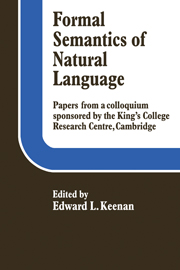Book contents
- Frontmatter
- Contents
- Notes on the contributors
- Acknowledgements
- Introduction
- I QUANTIFICATION IN NATURAL LANGUAGE
- II REFERENCE AND CROSS REFERENCE
- III INTENSIONAL LOGIC AND SYNTACTIC THEORY
- Two theories about adjectives
- Partial interpretations
- Subcategorization of adnominal and adverbial modifiers
- Should generative semantics be related to intensional logic?
- Transformational semantics
- IV QUESTIONING MODEL THEORETIC SEMANTICS
- V PRAGMATICS AND SENTENCES IN CONTEXT
- VI SEMANTICS AND SURFACE SYNTAX
Subcategorization of adnominal and adverbial modifiers
Published online by Cambridge University Press: 05 November 2011
- Frontmatter
- Contents
- Notes on the contributors
- Acknowledgements
- Introduction
- I QUANTIFICATION IN NATURAL LANGUAGE
- II REFERENCE AND CROSS REFERENCE
- III INTENSIONAL LOGIC AND SYNTACTIC THEORY
- Two theories about adjectives
- Partial interpretations
- Subcategorization of adnominal and adverbial modifiers
- Should generative semantics be related to intensional logic?
- Transformational semantics
- IV QUESTIONING MODEL THEORETIC SEMANTICS
- V PRAGMATICS AND SENTENCES IN CONTEXT
- VI SEMANTICS AND SURFACE SYNTAX
Summary
The topic of this paper1 is the role of adnominal and adverbial modifiers in sentence semantics. Before going into details I will sketch the framework in which this special problem will be treated. The framework is that of Natural Generative (NG) Grammar (Bartsch and Vennemann (1972)). A natural generative grammar comprises the following rules:
From the point of view of linguistic production
(a) Formation rules of a properly extended predicate logic (PEPL), i.e. a predicate logic extended by predicates over sentence intensions and by several sorts of individual variables and constants (multi-sortal logic).
(b) Formation rules of a categorial grammar of a natural language.
(c) Constituent building rules. They map forms built according to PEPL (a), the semantic representations, onto forms built in accordance with categorial syntax (b). If the formation rules of PEPL are understood as the generative component of the grammar, then the constituent building rules are conversion rules with semantic representations as input and categorial forms as output. The rules of categorial syntax then have to be understood as restrictions on the forms of the output of constituent building rules and thus as restrictions on the constituent building rules themselves.
(d) Lexicalization rules.
(e) Morphological rules.
(f) Serialization rules.
(g) Intonation rules.
The semantic representations as well as the forms of categorial syntax are not linearly ordered but only hierarchically ordered. Serialization rules apply to the forms of categorial syntax after lexicalization rules and morphological rules have applied.
- Type
- Chapter
- Information
- Formal Semantics of Natural Language , pp. 175 - 187Publisher: Cambridge University PressPrint publication year: 1975
- 2
- Cited by

